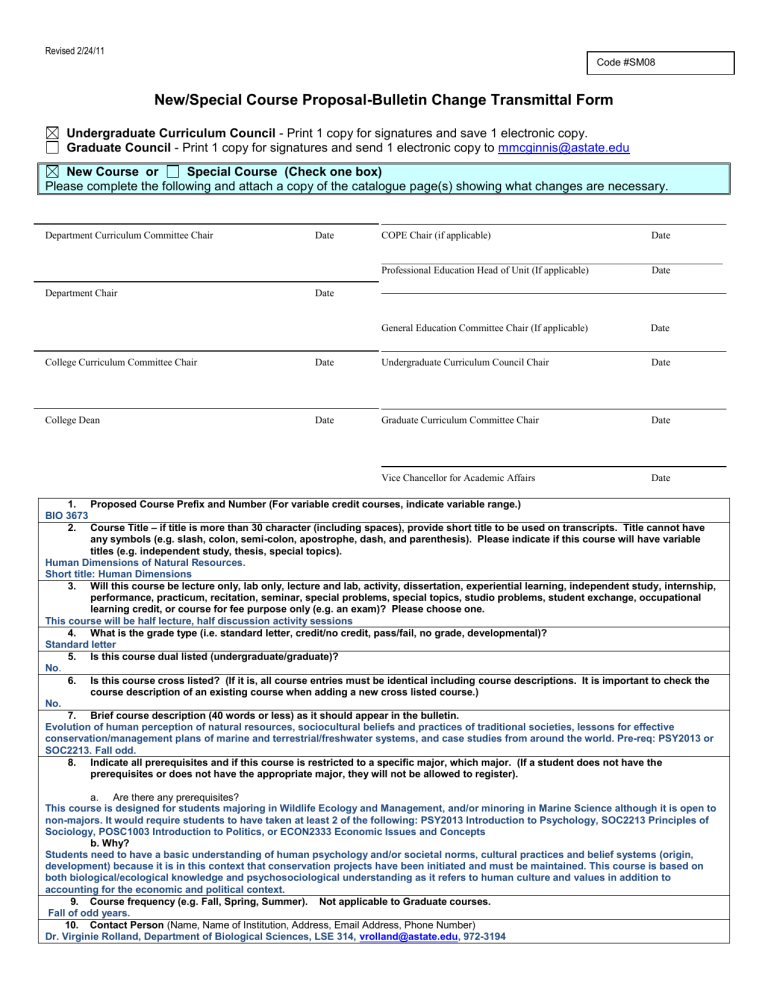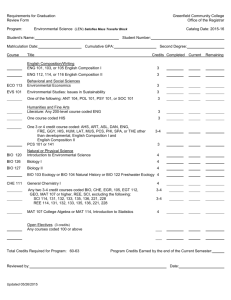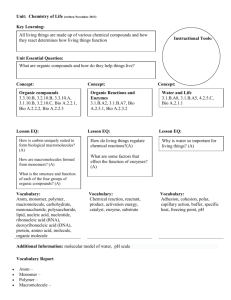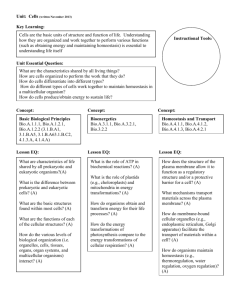New Program - Arkansas State University

Revised 2/24/11
Code #SM08
New/Special Course Proposal-Bulletin Change Transmittal Form
Undergraduate Curriculum Council - Print 1 copy for signatures and save 1 electronic copy.
Graduate Council - Print 1 copy for signatures and send 1 electronic copy to mmcginnis@astate.edu
New Course or Special Course (Check one box)
Please complete the following and attach a copy of the catalogue page(s) showing what changes are necessary.
Department Curriculum Committee Chair
Department Chair
College Curriculum Committee Chair
College Dean
Date
Date
Date
Date
COPE Chair (if applicable) Date
____________________________________________________________________
Professional Education Head of Unit (If applicable) Date
General Education Committee Chair (If applicable) Date
Undergraduate Curriculum Council Chair Date
Graduate Curriculum Committee Chair
Vice Chancellor for Academic Affairs
Date
Date
1. Proposed Course Prefix and Number (For variable credit courses, indicate variable range.)
BIO 3673
2. Course Title – if title is more than 30 character (including spaces), provide short title to be used on transcripts. Title cannot have any symbols (e.g. slash, colon, semi-colon, apostrophe, dash, and parenthesis). Please indicate if this course will have variable titles (e.g. independent study, thesis, special topics).
Human Dimensions of Natural Resources.
Short title: Human Dimensions
3. Will this course be lecture only, lab only, lecture and lab, activity, dissertation, experiential learning, independent study, internship, performance, practicum, recitation, seminar, special problems, special topics, studio problems, student exchange, occupational learning credit, or course for fee purpose only (e.g. an exam)? Please choose one.
This course will be half lecture, half discussion activity sessions
4. What is the grade type (i.e. standard letter, credit/no credit, pass/fail, no grade, developmental)?
Standard letter
5. Is this course dual listed (undergraduate/graduate)?
No .
6. Is this course cross listed? (If it is, all course entries must be identical including course descriptions. It is important to check the course description of an existing course when adding a new cross listed course.)
No.
7. Brief course description (40 words or less) as it should appear in the bulletin.
Evolution of human perception of natural resources, sociocultural beliefs and practices of traditional societies, lessons for effective conservation/management plans of marine and terrestrial/freshwater systems, and case studies from around the world. Pre-req: PSY2013 or
SOC2213. Fall odd.
8. Indicate all prerequisites and if this course is restricted to a specific major, which major. (If a student does not have the prerequisites or does not have the appropriate major, they will not be allowed to register). a. Are there any prerequisites?
This course is designed for students majoring in Wildlife Ecology and Management, and/or minoring in Marine Science although it is open to non-majors. It would require students to have taken at least 2 of the following: PSY2013 Introduction to Psychology, SOC2213 Principles of
Sociology, POSC1003 Introduction to Politics, or ECON2333 Economic Issues and Concepts b. Why?
Students need to have a basic understanding of human psychology and/or societal norms, cultural practices and belief systems (origin, development) because it is in this context that conservation projects have been initiated and must be maintained. This course is based on both biological/ecological knowledge and psychosociological understanding as it refers to human culture and values in addition to accounting for the economic and political context.
9. Course frequency (e.g. Fall, Spring, Summer). Not applicable to Graduate courses.
Fall of odd years.
10. Contact Person (Name, Name of Institution, Address, Email Address, Phone Number)
Dr. Virginie Rolland, Department of Biological Sciences, LSE 314, vrolland@astate.edu
, 972-3194
Revised 2/24/11
Dr. Paul Sikkel, Department of Biological Sciences, LSE 412, psikkel@astate.edu
, 972-3296
11. Proposed Starting Term/Year
Fall 2013
12. Is this course in support of a new program? If yes, what program?
The Wildlife Ecology and Management program is not new. However, the Marine Science minor is a new program.
13. Does this course replace a course being deleted? No.
b. If yes, what course? c. Has this course number been used in the past?
Attach Course Deletion Proposal-Bulletin Change Transmittal Form.
14. Does this course affect another program? If yes, provide contact information from the Dean, Department Head, and/or Program Director whose area this affects.
No .
15. Justification should include:
A.
Academic rationale and goals for the course (skills or level of knowledge students can be expected to attain).
Such a course is needed as communities across the globe are more connected nowadays with regards to the human impact on economy, environment and global resources.
This course should give students in wildlife ecology and management and marine science a better understanding of the seemingly contradictory nature of humankind when it relates to natural resources. Foundations will be laid early in the course, enabling students to apply their knowledge to real case studies taken from different parts of the world involving different ecosystems, human communities, and conservation issues. At the end of the course, students will not only understand the social and political context in which decisions are made, but they will also have the tools to communicate with a wide range of people (from media to stakeholders), conduct an inquiry, solve conflicts, and develop a management plan considering all concerns and interests from the inquiry.
B. How does the course fit with the mission established by the department for the curriculum? If course is mandated by an accrediting or certifying agency, include the directive.
By combining biology conservation with psychology and sociology, this course fits with the emphasis placed on interdisciplinary instruction in the Department of Biological Sciences. Students will have a better understanding of human interactions with one-another as well as the natural environment, and will be better prepared to appropriately approach different people involved in the implementation of a successful conservation/management plan.
C. Student population served.
This course will serve undergraduate students in the Wildlife Ecology and Management program, and students with a minor in Marine
Science, but will also be open to non-majors.
D. Rationale for the level of the course (lower, upper, or graduate).
Because students are required to have taken 2 lower-level courses in social sciences, it is appropriate that our proposed course is designated as an upper-level course. Also, an understanding of human dimensions is required to be eligible for the Wildlife Biologist certification for which many of our majors are likely to apply.
16. Outline (The course outline should be topical by weeks and should be sufficient in detail to allow for judgment of the content of the course.)
Week 1 – Introduction
Week 2 – Current conservation issues
Week 3 – Social science considerations
Week 4
– Biophilia
Week 5 – Conservation ethics and policies
Week 6 & 7 – Using human dimensions in practice
Week 8 & 9 – Case study I – Marine Protected Areas in the Philippines and Hawaii
Week 10
– Case study II – Seabirds and overharvest
Week 11
– Case study III – Elephants
Week 12 – Case Study IV - Indonesia
Week 13 & 14 – Oral Presentations
17. Course requirements (e.g. research papers, projects, interviews, tests, etc.)
To expose students to a real-world example, they will be asked to create, as a team, an inquiry, to survey different people (public, wildlife managers, media…) and interpret their results. This aspect will first be submitted to IRB review and approval. To assess students’ communication skills, they will have to do a summary of a paper from the journal Human Dimensions of Wildlife, and an oral presentation at the end of the semester. In addition, students will be regularly evaluated based on quizzes and a mid-term exam.
18. Special features (e.g. labs, exhibits, site visitations, etc.)
No
19. Required reading
Decker et al. (2012) Human Dimensions of Wildlife Management (2 nd
Ed.) Johns Hopkins University Press. This book is the initiative of the
Wildlife Society and will be used as a textbook. In addition, students will be asked to pick and read one book from a list we will provide. In this list will be included E. O. Wilson’s and A. Leopold’s works. Finally, the course will also be supplemented with current literature.
20. Department staffing and classroom/lab resources (Will this require additional faculty, supplies, etc.?)
This course will not require additional faculty, room space or supplies.
.
21. What is the primary goal of this course?
To help students realize that management of natural resources requires an understanding and managing of human behavior in addition to an understanding of the natural environment an d its “managed” inhabitants. In other words, being a wildlife biologist is not limited to the outdoors and proximity to animals, or to some technical training. There is also an important human dimension in the protection of our natural resources. Because everyone has a different perception of Nature, students in their future profession will undoubtedly have to deal with media and press, landowners, agency managers, citizens, or resource users (e.g., anglers, hunters, loggers, recreators). This course will provide students with the tools to navigate this multifaceted “landscape”.
22. If this proposal is for a general education course, please check the primary goal this course addresses:
Thinking Critically Communicating effectively
Revised 2/24/11
Using mathematics
Understanding global issues
Developing a life-long appreciation of the arts and humanities
Using science to accomplish common goals
Using Technology
Understanding interdependence
Developing a strong foundation in the social sciences
Providing foundations necessary to achieve health and wellness
23. Considering the indicated primary goal, provide up to three outcomes that you expect of students after completion of this course. For example, what will students who meet this goal know or be able to do as a result of this course?
At the completion of the course, the student will be able to:
1) Identify the importance of understanding the evolutionary and social/cultural basis for human perception and behavior towards natural resources and their conservation/management.
2) Give specific examples from case studies of the application of knowledge of the cultural practices of traditional societies to create effective management policies and practices by “modern” societies.
3) Effectively express orally and in writing an understanding of “human dimensions” applied to the development of a management plan.
From the most current electronic version of the bulletin, copy all bulletin pages that this proposal affects and paste it to the end of this proposal.
I believe it would affect p359 where requirements are listed. Human Dimensions should be one of the options wildlife majors should take, other options being Conservation Biology and Environmental Law and Administration.
It would also modify p361 for students who want a minor in Marine Science
Then, p525:
BIO 3501. Wild Flowers of Arkansas Identification and conservation of wild flowers in Arkansas, plus studying those that are edible, endangered or rare, poisonous, or may be used in flower gardens. Lecture one hour per week. Open to all majors. Special course fees may apply. Summer, odd every 4 years.
BIO 3511. Wild Flowers of Arkansas Laboratory Two hours per week. To be taken concurrently with BIO 3501. Special course fees may apply.
Summer, odd every 4 years.
BIO 3541. Plant Pathology Laboratory Two hours per week. To be taken concurrently with BIO 3542. Special course fees may apply. Spring, odd.
BIO 3542. Plant Pathology Nature, cause, and control of diseases of orchard, garden, and field crops. Lecture two hours per week. Special course fees may apply. Prerequisites, BIO 1501 and BIO 1503. Spring, odd.
BIO 3553. Economic Botany Economic plants and their use by man. Lecture three hours per week. Special course fees may apply. Prerequisites,
BIO 1501 and BIO 1503. Summer, even every 4 years.
BIO 3673. Human Dimensions. Evolution of human perception of natural resources, sociocultural beliefs and practices of traditional societies, lessons for effective conservation/management plans, case studies from around the world. Pre-req: PSY2013 or SOC2213. Odd Fall.
BIO 4001. Laboratory Techniques in Electron Microscopy An introduction to the preparation of biological materials for viewing with the transmission and scanning electron microscope. Emphasis will be placed on preparative techniques that are commonly used in the laboratory.
Lecture one hour per week. Special course fees may apply. Prerequisite, eight hours upper-level biology. Instructor permission required. Fall, even.
BIO 4003. Laboratory Techniques in Electron Microscopy Laboratory Six hours per week. To be taken concurrently with BIO 4001. Special course fees may apply. Fall, even.
BIO 4011. Microtechnique Methods of killing, fixing, staining, and mounting tissues. Lecture one hour per week. Special course fees may apply.
Prerequisites, BIO 1501, BIO 1503, CHEM 3103, and CHEM 3101. Fall, odd.
BIO 4012. Microtechnique Laboratory Four hours per week. To be taken concurrently with BIO 4011. Special course fees may apply. Fall, odd.
BIO 4013. Population Genetics This course will investigate the theories describing the temporal nature of the genetic structure of populations.
There will be an emphasis on problem solving applying statistical tools. Intended for students entering the disciplines of systematics, conservation, agriculture, and wildlife and fisheries sciences. Special course fees may apply. Fall, even years.
BIO 4021. Biological Seminar Conferences, readings, and reports on material relevant to the biological sciences. Required of all department majors. Open only to biology department majors with 16 hours or more of course work in the subject area. Special course fees may apply. Fall,
Spring, Summer.
BIO 4023. History of Biological Ideas This course analyzes the history of biological ideas such as evolution, heredity, spontaneous generation, and molecular biology, aimed at a better understanding not only of the historical background of current research but also on how science proceeds.
Special course fees may apply. Prerequisites will be at least two of the following courses, BIO 3033, BIO 3023, and BIO 3013. Permission of Instructor required. Fall, odd.
BIO 403V. Special Problems in Biology Specific area with the topic and mode of inquiry agreed upon by student and instructor. Registration may be repeated with various topics. Registration must be approved by the program director. Special course fees may apply. Demand.
BIO 404V. Special Topics in Biological Sciences Topical or technique driven seminar relating to the biological sciences that will lead to the training of students in a body of work, such as newly developed research technique and approach. Number of credit hours will vary. Special course fees may apply. Permission of Instructor required. May be repeated for a total credit of 6 hours. Fall, Spring.
BIO 4103. Virology The structure, function, and classification of viruses, and their impact on modern society and the biological world. Lecture three hours per week. Special course fees may apply. Prerequisites, BIO 2103 or BIO 3013 or BIO 4104 or BIO 4133. Fall, even.






